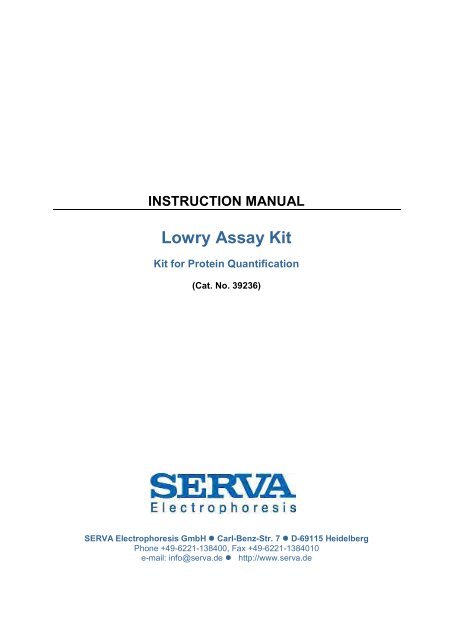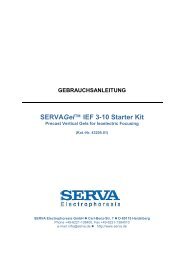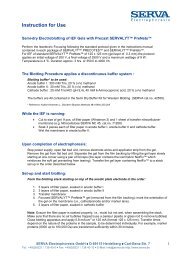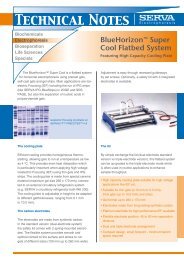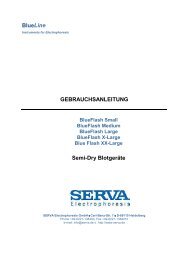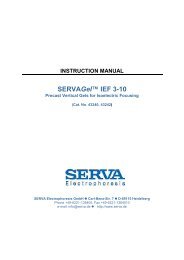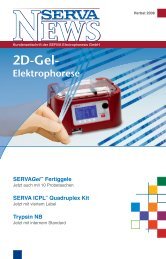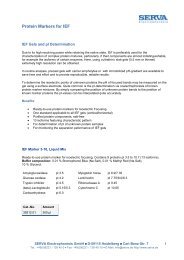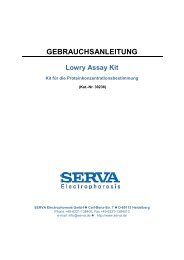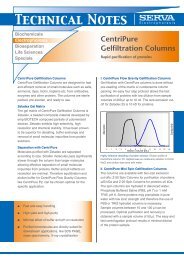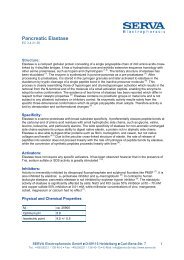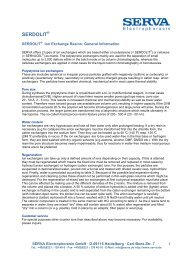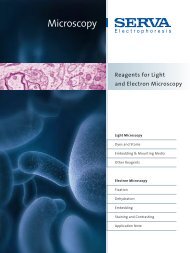1. Lowry Assay Kit - SERVA Electrophoresis GmbH
1. Lowry Assay Kit - SERVA Electrophoresis GmbH
1. Lowry Assay Kit - SERVA Electrophoresis GmbH
You also want an ePaper? Increase the reach of your titles
YUMPU automatically turns print PDFs into web optimized ePapers that Google loves.
INSTRUCTION MANUAL<br />
<strong>Lowry</strong> <strong>Assay</strong> <strong>Kit</strong><br />
<strong>Kit</strong> for Protein Quantification<br />
(Cat. No. 39236)<br />
<strong>SERVA</strong> <strong>Electrophoresis</strong> <strong>GmbH</strong> • Carl-Benz-Str. 7 • D-69115 Heidelberg<br />
Phone +49-6221-138400, Fax +49-6221-1384010<br />
e-mail: info@serva.de • http://www.serva.de
Contents<br />
<strong>1.</strong> <strong>Lowry</strong> <strong>Assay</strong> <strong>Kit</strong> 2<br />
<strong>1.</strong><strong>1.</strong> General Information 2<br />
<strong>1.</strong>2. <strong>Kit</strong> Components 2<br />
<strong>1.</strong>3. Additionally required equipment 2<br />
<strong>1.</strong>4. Storage conditions 2<br />
2. Procedure of the <strong>Lowry</strong> <strong>Assay</strong> 3<br />
2.<strong>1.</strong> Prepration of standards and reagents 3<br />
2.2. Preparation of BSA reference solutions 3<br />
2.3. Protein Quantification Procedure 3<br />
2.4. Calculation of Protein Concentrations 4<br />
3. Literatur 6<br />
Vers 11/10<br />
1
<strong>1.</strong> <strong>Lowry</strong> <strong>Assay</strong> <strong>Kit</strong><br />
<strong>1.</strong><strong>1.</strong> General Information<br />
<strong>Lowry</strong>’s method for protein estimation is a most widely acceptable method for<br />
accurate determination of protein concentration. <strong>SERVA</strong> <strong>Lowry</strong> <strong>Assay</strong> <strong>Kit</strong> is based on<br />
this method. It is a ready to use reagent kit for rapid estimation of protein with ease<br />
and consistancy.<br />
The method is based on combination of biuret reaction and Folin-Ciocalteau reaction.<br />
In the first step of the reaction protein binds to copper in alkaline medium and<br />
produces Cu ions. In the second step Cu ion catalyzes oxidation of aromatic<br />
aminoacids by reducing phosphomolybdotungstate to heteropolymolybdenum blue.<br />
This reaction produces strong blue colour which predominantly depend upon tyrosin<br />
and tryptophan content of protein and to a lesser extent cysteine and other residues<br />
in protein.<br />
<strong>1.</strong>2. <strong>Kit</strong> Components<br />
Component<br />
Protein Standard, BSA<br />
Solution A<br />
Solution B<br />
Solution C<br />
250 <strong>Assay</strong>s<br />
3 x 5 mg<br />
2,5 ml<br />
250 ml<br />
30 ml<br />
<strong>1.</strong>3. Additionally required equipment<br />
• Vortex mixer<br />
• Photometer suitable for measurement at 660 nm wavelength and the usage of<br />
microcuvettes<br />
• Plastic cuvettes<br />
<strong>1.</strong>4. Storage conditions<br />
The recommended storage temperature for the <strong>Lowry</strong> <strong>Assay</strong> <strong>Kit</strong> is +2 – 8 °C. Under<br />
these storage conditions the unopened reagent is at least useable until: see expiry<br />
date on the label.<br />
2
2. Procedure of the <strong>Lowry</strong> <strong>Assay</strong><br />
2.<strong>1.</strong> Prepration of Standards and Reagents<br />
2.<strong>1.</strong><strong>1.</strong> Standard Protein<br />
Reconstitute one vial containing 5 mg BSA with 1 ml distilled water to get 5 mg/ml.<br />
This is stable at 4 °C for two weeks.<br />
Dilute 0.2 ml of 5 mg/ml BSA solution with 0.8 ml distilled water to get <strong>1.</strong>0 mg/ml just<br />
before use.<br />
2.<strong>1.</strong>2. Complex forming reagent<br />
To one volume of Solution A add 100 volumes of Solution B just before use.<br />
2.<strong>1.</strong>3. Solution C<br />
Solution C is ready to use.<br />
2.2. Preparation of BSA Reference Solutions<br />
BSA<br />
[µg/tube]<br />
V(BSA solution<br />
1 mg/ml) [µl]<br />
0 0 1000<br />
10 10 990<br />
50 50 950<br />
100 100 900<br />
250 250 750<br />
500 500 500<br />
V(Diluent)<br />
[µl]<br />
2.3. Protein Quantification Procedure<br />
Presence of the following compounds in the sample is known to interfere in the assay<br />
and should be avoided.<br />
• Substances containing amine group.<br />
• High molarity buffers of low pH or strong acids. The pH of reaction mixture<br />
should be in the range of 10 - 10.5.<br />
• Detergents<br />
• Ammonium sulfate > 3 %<br />
• Sodium phosphate > 0.2 M<br />
• Cesium bicarbonate<br />
3
Protocol:<br />
• Pipette standard BSA 1 mg/ml, samples and distilled water referring to the<br />
protocol given in the following table and adjust the volume to 0.1 ml.<br />
• Add 1 ml complex forming reagent, mix and keep for 10 minutes.<br />
• Add 0.1 ml of Solution III with vortexing and incubate for 20 - 30 minutes.<br />
• Read the optical density on spectro-photometer at 660nm or on a colorimeter<br />
using suitable filter.<br />
Flowchart:<br />
Pipet 100 µl dist. H 2 O and buffer for blank, reference<br />
solutions and samples into test tubes<br />
Add 1 ml Complex forming reagent, mix and<br />
incubate 10 min at RT<br />
Add 100 µl Solution C<br />
Mix by vortexing<br />
Incubate 20 - 30 min at RT<br />
Transfer solutions to cuvettes<br />
Measure absorbance at 660 nm (A 660nm )<br />
2.4. Calculation of Protein Concentrations<br />
Create a table with the absorbance results obtained from the assay. From the values<br />
obtained for the BSA reference solutions create a calibartion curve which is used to<br />
determine the protein concentration in the unknown sample.<br />
Table 1 shows exemplary absorbance results for creation of the BSA calibration<br />
curve (samples were solved in water) and Graph 1 the consequentially resulting<br />
calibration curve.<br />
4
c(BSA)<br />
A 660nm<br />
[µg/mL]<br />
0 0<br />
0 0<br />
0 0<br />
10 0.01<br />
10 0.01<br />
10 0.01<br />
50 0.078<br />
50 0.082<br />
50 0.081<br />
75 0.129<br />
75 0.124<br />
75 0.128<br />
100 0.178<br />
100 0.18<br />
100 0.168<br />
250 0.373<br />
250 0.396<br />
250 0.403<br />
500 0.743<br />
500 0.757<br />
500 0.724<br />
Note:<br />
The data of these BSA references<br />
should not be used as a replacement of<br />
a calibration curve. The absorbance of<br />
the BSA reference solutions in each<br />
assay will differ from those presented<br />
here.<br />
Table 1: Example for assay data table of BSA reference solutions.<br />
Graph 1: BSA calibration curve produced from the assay data in Table <strong>1.</strong><br />
The data are fit with a linear regression by the line y = 0,0015 x + 0,0121 with an R 2 value of 0.9969.<br />
5
• Construct a calibartion curve by plotting optical density reading on y axis<br />
against standard protein amount (µg/tube) on the x axis<br />
• Record the value x for the protein amount per tube from the calibration curve<br />
corresponding to the optical density reading for inividual sample.<br />
• Calculate the sample concentration (C) by using the following formula:<br />
X [µg] / V [µl] = C [µg/µl] = C [mg/ml]<br />
X: protein amount of the sample<br />
V: sample volume used in the assay<br />
• Correct for predilution of samples if any by using the following formula:<br />
(X [µg] / V [µl]) * DF = C [µg/µl] = C [mg/ml]<br />
X: protein amount of the sample<br />
V: sample volume used in the assay<br />
DF: dilution factor<br />
3. Literature<br />
<strong>Lowry</strong> O. H., et al. (1951) J. Biol. Chem. 193, 265 – 275.<br />
6


